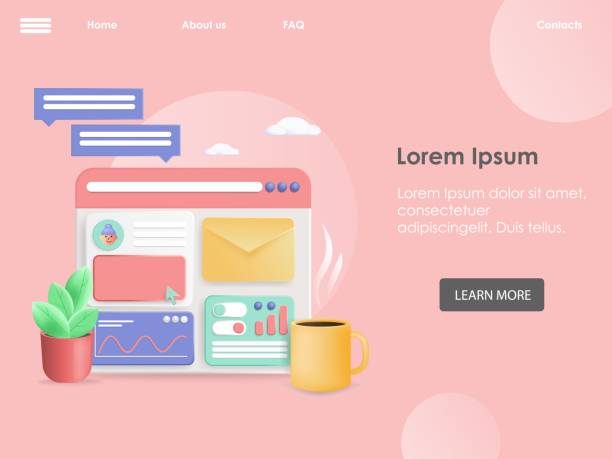Introduction to SEO-Optimized Website Design and Its Importance

In today’s digital world, merely having a website is not enough; your website must be seen.
This is where the concept of #SEO_Optimized_Website_Design becomes important.
#SEO, or #Search_Engine_Optimization, is a process that helps you improve your website’s ranking in Google and other search engine results.
Imagine you have a business and offer your products or services online.
If your website does not appear on the first pages of Google, most of your potential customers will probably never find it.
Therefore, SEO is not just an option, but a necessity for survival and growth in the online space.
When we talk about SEO-optimized website design, we mean creating a website from scratch, considering all the factors that search engines use for ranking.
This proactive approach is much more efficient than trying to SEO-optimize a website after it has been built.
Because the core structure of the website, its coding, loading speed, and user experience must align with SEO principles from the very beginning.
SEO-optimized website design means creating a website that is understandable and accessible to both users and search engine robots.
This process includes choosing the right URL structure, proper use of HTML tags, image optimization, and ensuring the website is responsive (correct display on various devices).
In fact, the importance of SEO-optimized website design lies in turning your website into a powerful asset for digital marketing.
Without SEO, even the best content or most beautiful website design might remain in obscurity.
According to statistics, over 50% of website traffic comes from organic search.
This means half of your opportunities to attract customers are provided through search engines.
Therefore, investing in SEO-optimized website design is actually an investment in visibility, increased traffic, and ultimately, increased sales and revenue.
This is a comprehensive approach that requires a deep understanding of how search engines work, as well as user behavior, to ensure that your website not only ranks high but also converts visitors into customers.
Does your current e-commerce website design cause you to lose customers and sales?
Rasaweb is your solution with modern and user-friendly e-commerce website design!
✅ Significant increase in conversion rates and sales
✅ Strong branding and building customer trust
⚡ Get a free e-commerce website design consultation from Rasaweb!
Basic SEO Principles in Website Design

For an SEO-optimized website design, understanding the basic principles of #Technical_SEO is crucial.
These principles help search engines properly index and rank your website.
One of the most important of these principles is crawlability and indexability.
Search engine robots (crawlers) must be able to easily find all pages of your website and understand their content.
This includes a logical website structure, using an XML sitemap and a robots.txt file, which tell crawlers which pages to examine and which to ignore.
Ensuring that no important page is blocked is the first step in any successful SEO-optimized website design.
Another principle is website loading speed.
Today’s users are impatient, and if a website takes more than a few seconds to load, they will likely leave it.
Google also considers site speed as a ranking factor.
Image optimization, caching, file compression, and choosing appropriate hosting all contribute to improving site speed.
In an SEO-optimized website design, every millisecond counts.
Also, Responsive Design for correct display on mobile and tablet is an undeniable principle.
Given the significant increase in mobile device usage for searching, a website that does not display well on mobile not only provides a poor user experience but also suffers a drop in Google’s mobile rankings.
Proper URL structure and content hierarchy are also important foundations of SEO.
URLs should be short, descriptive, and contain keywords.
For example, instead of yoursite.com/page?id=123, use yoursite.com/services/website-design.
Content hierarchy (logical use of Heading tags from H1 to H6) also helps search engines understand the structure and main topic of the page.
These basic principles must be considered from the outset during SEO-optimized website design to prevent costly refactoring in the future and to ensure your website has a strong foundation for growth in search results from the moment it launches.
This comprehensive and foundational approach guarantees long-term success in today’s competitive online environment.
Keyword Research and Engaging Content for SEO-Optimized Website Design

One of the most important pillars of SEO-optimized website design is comprehensive and targeted keyword research.
#Keywords not only show you what your audience is looking for, but also help you produce content that exactly matches their needs and questions.
This process involves identifying words and phrases that users enter into search engines to find products, services, or information related to your business.
Using tools like Google Keyword Planner, Ahrefs, SEMrush, or even related Google searches can provide valuable insights into search volume, competition, and User Intent.
Is the user looking to buy, or merely researching and gathering information? The answer to this question determines the type of content you should produce.
After identifying suitable keywords, the next step is to produce engaging and high-quality content.
Content is king, but not just any content.
Your content must be valuable, unique, and comprehensive enough to cover all aspects of the topic.
In the context of SEO-optimized website design, content must not only naturally incorporate target keywords but also answer users’ questions and solve their problems.
This can include blog articles, guides, infographics, videos, and even product pages with comprehensive descriptions.
Quality content naturally attracts links and is shared, which significantly helps improve SEO.
In addition to quality, freshness and up-to-dateness of content are also of high importance.
Search engines are interested in new and updated content, as it indicates continuous activity and the provision of accurate information.
Planning a content calendar and regularly updating old content can help maintain your website’s ranking in search results.
An SEO-optimized website design is not limited to good coding and technical structure; it also requires a strong and continuous content strategy that can attract and retain users.
The table below shows examples of keyword research tools and their features.
| Tool Name | Main Features | Type of Use | Free Version Limitations |
|---|---|---|---|
| Google Keyword Planner | Search volume, competition, new keyword suggestions | Finding keywords for advertising and SEO | Requires an active advertising campaign to view accurate data |
| Ahrefs Keywords Explorer | Competitor analysis, keyword ideas, keyword difficulty | Comprehensive keyword and competitor analysis | Very limited or no access without subscription |
| SEMrush Keyword Magic Tool | Keyword analysis, SERP analysis, keyword grouping | Keyword discovery and market analysis | Daily search limits |
| Google Trends | Search trends, keyword comparison, geographical popularity | Identifying new trends and seasonal changes | No major limitations, but does not provide precise search volume data |
| KWFinder | Finding Long-Tail keywords, low SEO difficulty | Focus on less competitive keywords | Limited number of searches in the free version |
These tools help you build your content strategy on real data and ensure that every piece of content moves towards your SEO-optimized website design goals.
Producing content that is both engaging for users and loved by search engines will be the main key to your website’s long-term SEO success.
Technical SEO in Practice

Technical optimization is one of the crucial aspects of SEO-optimized website design that directly affects how search engines interact with your website.
#Technical_SEO focuses on improving server-side elements and website coding to make it easier for search engines to crawl and index it.
One of these important elements is Schema Markup or structured data.
These codes help search engines better understand your website’s content and display specific information such as reviews, product prices, event times, or contact information prominently in search results (Rich Snippets).
Proper use of schema can significantly increase your click-through rate (CTR), even if your ranking doesn’t change.
The robots.txt file and XML sitemap are two other essential tools in technical SEO.
The robots.txt file tells search engine crawlers which parts of your website not to crawl (e.g., login pages or admin panels) so that your crawling resources are directed towards more important pages.
The XML sitemap also provides search engines with a list of all important pages on your website, helping them easily discover and index all your content.
Ensuring the accuracy and up-to-dateness of these files is an essential part of any SEO-optimized website design.
Also, Canonical Tags play an important role in preventing duplicate content issues.
When a page has similar content across multiple URLs, the canonical tag tells search engines which version of the page is the original and authoritative one and should be indexed.
This prevents search engine confusion and the division of authority among similar URLs.
Image optimization (compression and proper alt tag usage), using HTTPS for security, and correct management of redirects (301 and 302) are also other key aspects of technical SEO that must be considered during SEO-optimized website design.
All these measures together ensure that your website is technically optimized for search engines and that there are no obstacles to its crawling and ranking.
Are you bothered by losing customers due to your e-commerce website’s outdated appearance or slow speed? Rasaweb’s expert team solves these problems with professional e-commerce website design!
✅ Increased customer trust and brand credibility
✅ Stunning speed and excellent user experience
Get a free consultation with Rasaweb right now ⚡
The Role of User Experience (UX) in Website SEO

In recent years, the connection between User Experience (UX) and SEO has become increasingly prominent.
It is no longer possible to imagine an SEO-optimized website design without considering user comfort and satisfaction.
#Google increasingly focuses on factors that reflect the user’s experience on the website.
Metrics such as Core Web Vitals (including Largest Contentful Paint, First Input Delay, and Cumulative Layout Shift), which measure website loading speed, interactivity, and visual stability, directly impact your ranking.
A website that loads quickly, is easily navigable, and presents its content clearly and accessibly provides a positive user experience, which Google also rewards.
A website with strong UX usually improves metrics such as User Dwell Time and Bounce Rate.
If users quickly leave your website after entering (high bounce rate), this sends a negative signal to Google that your content was not relevant or useful.
Conversely, if users spend a lot of time on your site and visit different pages, this indicates satisfaction and the value of your content.
Therefore, in the process of SEO-optimized website design, special attention must be paid to visual layout, text readability, ease of navigation, and clear calls-to-action.
Responsive design and Accessibility are also integral parts of UX.
A website that displays correctly on all devices (desktop, tablet, mobile) and is accessible to people with disabilities (e.g., by using Alt tags for images or supporting keyboard navigation) not only expands your audience but also helps your SEO.
Google always emphasizes the importance of providing the best experience to its users, and this includes delivering results that point to websites with excellent UX.
Therefore, every step towards improving user experience is a step towards strengthening your website’s SEO.
This synergy between UX and SEO brings a new and successful approach to SEO-optimized website design that ensures sustainable results and continuous growth in the long term.
Link Building and Domain Authority for an Optimized Website

One of the strongest ranking factors in SEO, especially for SEO-optimized website design, is Link Building and increasing domain authority.
#Links act as votes of confidence from other websites.
The more authoritative and relevant websites link to your website, the more your domain authority with Google increases, and consequently, your ranking in search results improves.
But the important point is that link quality is more important than their quantity.
One link from a highly authoritative and relevant website is worth many times more than dozens of links from low-quality or irrelevant websites.
Link building includes two main parts: Internal Links and External Links.
Internal links are links that connect different pages of your website to each other.
This helps search engines better understand your website’s structure and transfer link equity between different pages.
In an SEO-optimized website design, the internal linking strategy should be determined from the outset, and related content should be linked to each other to both improve user experience and strengthen internal SEO.
External links (backlinks) are links given to your website from other websites.
Attracting quality backlinks can be achieved through producing valuable and shareable content, participating in online communities, digital public relations, or even guest posts on relevant blogs.
It is important to avoid illicit or spammy link-building methods (such as buying links), as these methods can lead to Google penalties and seriously damage your website’s credibility.
Domain Authority and Page Authority are metrics used by SEO tools (like Moz) to estimate the strength and authority of a specific website or page.
The goal in SEO-optimized website design is to naturally and sustainably increase these authorities so that your website is recognized as an authoritative source in its industry.
Remember that link building is a time-consuming and continuous process, and its results appear gradually.
Focusing on building relationships with other webmasters, producing content that naturally attracts links, and monitoring your backlink profile are all essential parts of a successful link-building strategy that significantly contribute to the stability and growth of your website’s SEO over time.
This continuous effort, alongside foundational SEO-optimized website design, guarantees success in online competitions.
SEO Monitoring Tools and Techniques for Continuous Improvement

After the SEO-optimized website design stage and implementing initial strategies, the monitoring and continuous improvement phase begins.
#SEO_Monitoring allows you to track your website’s performance in search engines, identify problems, and discover new opportunities for improvement.
Various tools are available for this purpose, each providing valuable information.
Google Search Console (GSC) is a free and essential tool from Google itself that provides direct information on how your website is viewed by Google.
This information includes crawl reports, page indexing, website errors, search performance (keywords, clicks, impressions), and security issues.
Google Analytics is another free and powerful Google tool that provides detailed information about user behavior on your website.
This includes the number of visitors, pages visited, time spent on site, bounce rate, and traffic sources (organic search, social media, referrals).
By analyzing Google Analytics data, you can gain a deeper understanding of how users interact with your website and, based on that, optimize your content strategies and SEO-optimized website design.
| Tool Name | Main Uses | Data Type | Free Access Level |
|---|---|---|---|
| Google Search Console | Index health, search performance, technical errors, inbound links | Google-centric data | Completely free |
| Google Analytics | User behavior, traffic sources, conversion rates, visitor demographics | User behavior data | Completely free (with API limitations for version 3) |
| Ahrefs | Backlink analysis, keyword research, competitor analysis, rank tracking | Comprehensive SEO and marketing data | Paid, very limited free version |
| SEMrush | Keyword research, competitor analysis, technical SEO, content marketing | Comprehensive SEO and marketing data | Paid, limited free version |
| Moz Pro | Domain Authority, Page Authority, keyword research, Crawl Diagnostics | SEO and domain authority data | Paid, limited free version |
In addition to these essential tools, there are also more advanced paid tools such as Ahrefs, SEMrush, and Moz Pro, which offer broader capabilities like in-depth backlink analysis, competitor keyword research, keyword ranking monitoring, and comprehensive technical SEO audits.
Using these tools helps you gain a 360-degree view of your website’s SEO status and adjust your strategies based on accurate data.
Continuous monitoring techniques include regularly reviewing GSC and GA reports, periodic technical SEO audits, and competitor analysis to identify new opportunities.
This continuous approach to improvement keeps your website on an upward trajectory in rankings and ensures that your SEO-optimized website design remains optimized and effective over time.
Website Security and Stability as SEO Factors

In today’s risky digital world, website security is not only vital for protecting user information but has also increasingly become an important factor in #SEO.
#Website_Security and its stability are directly related to the credibility and trust search engines have in your website.
Google has officially stated that using HTTPS (Hypertext Transfer Protocol Secure) is a ranking signal.
Websites that use HTTPS encrypt information between the user’s browser and the website’s server, preventing data theft.
This not only benefits SEO but also increases user trust in your website.
Therefore, in SEO-optimized website design, implementing an SSL certificate and using HTTPS from the very beginning is a requirement.
Website stability (Uptime) and server response speed are also important factors.
If your website is frequently down or its server response speed is low, this harms your user experience and SEO.
Search engines prefer to rank websites that are always available and load quickly.
Choosing a reliable and powerful hosting service, using a Content Delivery Network (CDN), and monitoring website uptime all contribute to improved stability.
These factors indirectly affect SEO because they impact bounce rate, dwell time, and ultimately, user interaction with the site.
In addition, protection against cyber attacks like DDoS or SQL injection is also very important.
A hacked website can not only damage your credibility but may also be removed from search results by Google.
Implementing a Web Application Firewall (WAF), regular updates of the Content Management System (CMS) and plugins, and regular data backups are all measures that ensure your website’s security.
Ultimately, a comprehensive approach to SEO-optimized website design also includes attention to security and stability aspects.
This ensures that your website is not only safe and reliable for users but also has sufficient credibility and stability for search engines to achieve high rankings in search results.
A secure and stable website will be a solid foundation for any successful online activity.
Does your current site showcase your brand’s credibility as it should? Or does it scare away potential customers?
Rasaweb, with years of experience in professional corporate website design, is your comprehensive solution.
✅ A modern, beautiful website tailored to your brand identity
✅ Significant increase in lead generation and new customers
⚡ Contact Rasaweb now for a free corporate website design consultation!
The Future of SEO-Optimized Website Design and New Trends

The world of SEO and SEO-optimized website design is constantly evolving, and to maintain a competitive edge, one must be aware of the latest #SEO_Trends and advancements.
One of the most important trends we have witnessed in recent years is Google’s increased focus on overall user experience and searcher intent.
Google’s algorithms have become smarter and no longer rely solely on keywords; they seek to fully understand the meaning behind a search and provide the best possible answer.
This means a greater focus on comprehensive, relevant, and high-quality content that truly addresses user needs.
Voice Search is also one of the growing trends.
With the increasing use of voice assistants like Siri, Google Assistant, and Alexa, optimizing websites for voice search has gained increasing importance.
Voice searches are usually longer and more natural (e.g., “best Italian restaurant near me” instead of “Italian restaurant”).
Therefore, in SEO-optimized website design, the focus should be on long-tail keywords and answering direct questions.
Also, Artificial Intelligence (AI) and Machine Learning (ML) play an increasing role in Google’s algorithms (such as RankBrain, BERT, and MUM).
These technologies help Google better understand content and improve search results based on the complexities of natural language and search context.
The concept of E-A-T (Expertise, Authoritativeness, Trustworthiness) has also been increasingly emphasized by Google, especially for YMYL (Your Money Your Life) websites such as medical or financial websites.
Google wants to ensure that the information provided in these fields is published by reputable and trustworthy experts.
Therefore, in SEO-optimized website design, emphasis should be placed on building credibility, demonstrating expertise, and gaining the trust of users and search engines.
This includes displaying author information, citing credible sources, and gathering positive reviews and ratings.
Finally, continuous Google algorithm updates mean that SEO is a dynamic and ongoing process.
Websites and SEO professionals must be ready to adapt to changes and continuously update their strategies to remain on the path to successful SEO-optimized website design.
Conclusion and Next Steps for Successful SEO

Up to this point, we have examined various aspects of SEO-optimized website design.
From the fundamental importance of SEO and technical considerations to the vital role of content, user experience, and link building, all these factors combined set a website on the path to online success.
#SEO is not a one-time project, but a #continuous_strategy that requires ongoing attention and updates.
To achieve high rankings in search results and maintain this position, you must constantly be learning, monitoring, and optimizing.
Every day, search engine algorithms become more complex and intelligent, and competition in the online space intensifies.
The next step after understanding the principles of SEO-optimized website design is their practical implementation.
This includes regular SEO audits to identify strengths and weaknesses, competitor analysis to discover new opportunities, and continuous production of valuable and user-centric content.
Proper use of SEO tools and data analysis helps you make informed decisions and measure the effectiveness of your strategies.
Remember that patience and perseverance are two key factors in SEO success.
SEO results are usually not immediately visible and may take weeks or even months for the changes to show their impact.
Ultimately, success in SEO-optimized website design means providing the best possible experience to users.
Google and other search engines are always looking for websites that best meet users’ needs.
Therefore, if your website is fast, secure, easy to use, and contains valuable content, you will have a very high chance of achieving top rankings and attracting organic traffic.
By adhering to all these principles and taking a comprehensive approach, you can ensure that your website will be a powerful driving force for your online business, not only now but also in the future, continuously attracting new customers towards you.
Frequently Asked Questions
| Question | Answer |
|---|---|
| What is SEO-optimized website design? | SEO-optimized website design means creating a website that is not only attractive and user-friendly for users but also has its structure and content optimized for search engines (like Google) to achieve higher rankings in search results. |
| Why is SEO-optimized website design important? | SEO-optimized website design increases your website’s visibility in search engines, attracts more organic (free) traffic, boosts your brand’s credibility and trust, and ultimately leads to increased sales and customers. |
| What are the key factors in SEO-optimized website design? | Key factors include site loading speed, responsiveness (mobile compatibility), proper URL structure, correct use of title and description tags (Meta Title & Description), image optimization, high-quality and user-friendly content, and internal and external link building. |
| What is the role of content in website SEO? | Content is king. High-quality, unique, relevant, and up-to-date content that naturally incorporates target keywords plays a crucial role in attracting users and sending positive signals to search engines. |
| What impact does site speed have on SEO? | Site speed is one of Google’s important ranking factors. Slow sites provide a poor user experience and can lead to an increased Bounce Rate, which harms your SEO ranking. |
| What does responsive website design mean and why is it important for SEO? | Responsiveness means that your website displays correctly on any device (mobile, tablet, laptop). Since most searches are done via mobile, Google prioritizes responsive sites. |
| How do we choose appropriate keywords for a website? | Choosing appropriate keywords is done by researching and analyzing user needs and competitors. Using tools like Google Keyword Planner, Ahrefs, or Semrush can help in finding high-volume and relevant keywords. |
| What is the importance of internal and external link building in SEO? | Internal link building helps improve site navigation, distribute Page Authority, and aid search engine crawling. External links (backlinks) from reputable sites are also a sign of your site’s authority and expertise for Google. |
| What is the role of User Experience (UX) in SEO? | Good user experience means ease of use, visual appeal, and user satisfaction with the site. Good UX encourages users to stay on the site longer and interact more, which are considered positive signals for SEO ranking. |
| What tools are available for website SEO analysis? | Numerous tools are available for SEO analysis, including Google Search Console for examining site performance in search, Google Analytics for traffic analysis, GTmetrix and PageSpeed Insights for speed testing, and paid tools like Ahrefs and Semrush for comprehensive SEO and competitor analysis. |
And other services of Rasaweb Advertising Agency in the field of advertising
- Smart Sales Automation: A fast and efficient solution for campaign management focusing on marketing automation.
- Smart Brand Identity: An effective tool to increase click-through rates with attractive UI design.
- Smart Brand Identity: Professional optimization for customer behavior analysis using SEO-driven content strategy.
- Smart Website Development: Designed for businesses looking to manage campaigns through custom programming.
- Smart Brand Identity: An effective tool for user engagement with precise audience targeting.
And over hundreds of other services in the field of internet advertising, advertising consulting, and organizational solutions
Internet Advertising | Advertising Strategy | Advertorial
Resources
SEO-Oriented Website Design Guide
The Importance of SEO in Website Success
Technical SEO Tips for Websites
Content Strategy and SEO
? To reach the peak of success in the digital world, Rasaweb Afarin, by providing comprehensive digital marketing services including modern UI website design, is your business’s guide.
📍 Tehran, Mirdamad Street, next to Bank Markazi, Southern Kazeroun Alley, Ramin Alley, No. 6



